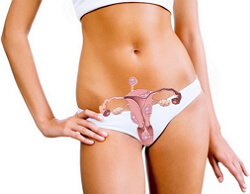Hypoplasia of the uterus
 Hypoplasia of the uterus is the most "popular" anomaly of development of the uterus, sometimes of an innate nature. The essence of the process of uterine hypoplasia is underdevelopment, that is, the discrepancy of its size with the age norm. The weakly expressed form of uterine hypoplasia occurs most often.
Hypoplasia of the uterus is the most "popular" anomaly of development of the uterus, sometimes of an innate nature. The essence of the process of uterine hypoplasia is underdevelopment, that is, the discrepancy of its size with the age norm. The weakly expressed form of uterine hypoplasia occurs most often.
The frequency of occurrence of abnormalities of the development of the uterus, including hypoplasia, is largely understated, because in some cases their primary diagnosis does not give an accurate idea of the nature and form of the anomaly.
The uterus of an adult woman is represented by a smooth-muscular hollow organ, similar in shape to an inverted pear. In the uterus, the body and the bottom( wide upper part) are clearly distinguished, as well as the neck( narrow lower part).The body of the uterus is connected to the neck by means of an isthmus. The part of the cervix that is accessible for examination in the mirrors is called vaginal. In the cavity of the small pelvis, the uterus is retained with the help of uterine ligaments.
The cervix is an integral part of the uterus, it is not a separate organ and is mutated to varying degrees in conjunction with the uterus. Therefore, hypoplasia of the uterus body and hypoplasia of the cervix are part of one process. Hypoplasia of the uterus is accompanied by a change in the shape and length of its cervix, so the diagnosis of cervical hypoplasia is usually not set.
Nature has presented this unique body to the woman for bearing and giving birth to a child. The muscular wall of the uterus is very powerful and elastic, it is able not only to stretch many times and hold a fruit weighing almost 5 kg during pregnancy, but also to push it out during childbirth.
The uterus begins to form on the fifth week of embryo development and grows very slowly up to 9 - 10 years of age. Rapid growth of the uterus begins after 10 years and reaches its normal physiological parameters to the period of puberty, that is, 13 to 14 years. The process of proper development of the uterus can be disturbed at the very beginning, when the girl is still in the womb of the mother. Much more common is hypoplasia of the uterus, not associated with intrauterine developmental disorders.
If the uterus of an adult woman does not correspond to the age norm, we can talk about its underdevelopment, or hypoplasia. Before making such a verdict, it is necessary to take into account not only the age of the patient and the average values of the normal size of the uterus: after the birth( especially multiple), the uterus increases in size, and in miniature nulliparous women, the uterus may have dimensions corresponding to the lower limit of the norm. The average statistical data determine the minimum size of the uterus as 3.8 cm( body length) x 2.7 cm( body thickness) x 3.7 cm( body width).
Hypoplasia of the uterus is not often found as a single symptom. In most cases, it accompanies a delay in sexual development in adolescents, menstrual irregularities of various types, including amenorrhea, infertility, and polycystic ovary.
In genetic and chromosomal abnormalities( eg, Turner's syndrome), girls develop uterine and ovarian hypoplasia as a manifestation of delayed puberty.
Causes of uterine hypoplasia
The causes of congenital hypoplasia of the uterus are disturbances in the normal development of the embryo, which can be associated with hereditary( genetic) anomalies or with an influence on the growing fetus of unfavorable factors.
Much more common is the uterine hypoplasia, not associated with congenital developmental anomalies. The reasons for the "acquired" hypoplasia are very diverse, they include:
- Any lesions of the CNS( pituitary-hypothalamus) traumatic, toxic or infectious nature, stresses( conflicts in school and / or in the family, emotional experiences), epilepsy;
- Tumors of the pituitary and hypothalamus, leading to a violation of hormonal regulation of normal maturation of genital organs;
- Severe extragenital diseases - chronic renal or hepatic insufficiency, uncompensated heart defects, etc.;
- Endocrine diseases - diabetes, hypothyroidism, hyperprolactinaemia, etc.;
- Dyshormonal condition due to ovarian failure after childhood infections( parotitis, measles rubella and others) or against cysts and ovarian tumors. In addition, underdevelopment of the uterus can occur against a background of underdevelopment of the ovaries, in this case, the uterine and ovarian hypoplasia will be present in the syndrome of delayed puberty;
- Deficiency of weight due to poor nutrition or irrational diets;
- Taking drugs, alcohol, psychotropic drugs, smoking;
- Traumatic operations on the ovaries in children with damage to the follicular apparatus or removal of the ovaries;
- To the underdevelopment of the genital organs lead and increased physical activity, not corresponding to individual physiological data( ballet, gymnastics, figure skating and others).Some parents show excessive zeal in the education of girls, writing them in all kinds of sections and circles, not in proportion to the physical and emotional capabilities of their child. As a result, the child's body begins to experience total stress, negatively affecting the development of the sexual organs;
- Chronic infectious diseases. Among patients with uterine hypoplasia, many often ill girls;
- Hereditary predisposition. The presence of an underdeveloped uterus( or uterus and appendages) in the next of kin( mother, sister) increases the chances of a similar anomaly in the girl in the puberty period.
Symptoms and signs of uterine hypoplasia
Congenital maldevelopment of the uterus refers to malformations of the genitalia and is diagnosed in early childhood. As a rule, such children are examined and treated together with endocrinologists, pediatricians and geneticists.
Much more often gynecologists have to deal with a neuropathic form of uterine hypoplasia. The most common reasons for contacting a gynecologist are:
- If the girl has never had menstruation before the age of 16 or started much later than this age;
- Menstrual cycle disorders. Menstruation irregular, sometimes painful, the amount of lost blood in some is very small, while in others, on the contrary, it is abundant;
- Primary infertility, premature termination of pregnancy at different times( from miscarriage to premature birth).
Underdevelopment of the uterus and vagina is a particular manifestation of general infantilism. Infantile girls, as a rule, are of small stature, thin-boned, with a narrow pelvis and flat buttocks, poorly developed mammary glands and poor hairiness under the armpits and pubic hair.
During the conversation, you can identify the presence of predisposing factors and adverse effects on the body in childhood.
The result of a gynecological examination depends on the specific clinical situation. If the uterine hypoplasia is negligible, the doctor can only suspect its presence on the basis of the following signs: small uterine sizes and excessive anterior deflection( hyperanteflexia) with the formation of an acute angle between the body and neck.
Girls with common infantilism show signs of genital infantilism: scanty pubic hair, small vulva and underdeveloped labia, short and narrow vagina with poorly developed arches and small folding, abnormal ratio of uterine and cervical dimensions.
Hormonal examination is carried out for all patients with uterine hypoplasia in order to establish violations of the development of sex steroids of various types. In women with infertility, anovulation is detected. In addition, the hormonal function of the thyroid gland is examined.
Ultrasonic scanning( ultrasound) of the pelvic organs provides much more information about changes in the uterus and appendages than a gynecological examination and is prescribed to all patients with suspected anomalies in the development of the genitals. Direct echopriznaki uterine hypoplasia are crucial in setting the final diagnosis. Reliable echopriznacs of uterine hypoplasia look as follows: uterus sizes do not correspond to the age norm( less), the ratio of the neck and body of the uterus is violated, excessive "bend" of the uterus in front. Along with the listed changes, undeveloped ovaries and convoluted fallopian tubes can be identified.
When examining patients with uterine hypoplasia, an x-ray examination is sometimes performed - hysterosalpingography. It allows differential diagnosis between the infantile uterus and uterine hypoplasia.
Consultations of related specialists are conducted in the case of a combination of uterine hypoplasia with non-gynecological diseases. Degrees of Hypoplasia of the Uterus
The process of forming the uterus is very long and is influenced by many factors. Damage to proper regulation of the growth of the uterus can occur at different stages - this may be the time of the initial laying of the body at the embryo stage, or the uterus may stop developing at the puberty stage. The time of damage to the normal mechanisms of the development of the uterus determines the very nature( degree) of underdevelopment:
- Hypoplasia of the uterus of the 1st degree .The most severe degree of underdevelopment of the uterus is a rudimentary, or embryonic, uterus. Its presence suggests that the uterus was not originally formed correctly and could not develop in the future. The length of the rudimentary uterus does not exceed 1 to 3 cm, and half of its length is the neck. This situation is extremely rare and is the cause of amenorrhea and infertility. Recovery of reproductive function in the embryonic uterus is impossible.
- Hypoplasia of the uterus of the 2nd degree .The infantile womb is larger than the rudimentary( more than 3 cm), but the ratio of her body and neck remains the same. In some obsolete medical sources, this uterus was called an "English pipe" because of the ratio of the cervix to the body( 3: 1), like that of a teenage girl. Menstrual function is represented by irregular, meager and painful menstruation. During the examination, signs of sexual and / or general infantilism are revealed. The prognosis is relatively favorable: in some cases, prolonged correction of hormonal and metabolic disorders can restore reproductive function.
- Hypoplasia of the uterus of the 3rd degree .Hypoplastic uterus does not exceed 7-8 cm in length, and the ratio of neck and body( 3: 1) corresponds to the anatomical norm. The reason for going to the doctor may be later on the beginning of menstruation or problems with conception. This degree of hypoplasia is amenable to therapy. Sometimes hypoplasia of this degree passes independently. This can be explained by the fact that during the examination of patients with suspected uterine underdevelopment, hyperdiagnosis may occur, especially in the case of the hypoplastic uterus. The doctor reassesses the degree of uterine underdevelopment, taking the minimum permissible size of the uterus( or minor deviations from the lower acceptable limit) for developmental disorders.
Treatment of uterine hypoplasia
From the treatment of hypoplasia, the uterus is refused in case of severe forms( rudimentary uterus, expressed by sexual infantilism).To determine the prospects for treatment in other cases help hormonal and instrumental( ultrasound, X-ray examination) survey methods. The basis of therapy is adequate hormonal treatment based on individually selected schemes.
Most often, women with uterine hypoplasia ask the question: can I get pregnant with uterine hypoplasia, and want to hear the most accurate response possible. Meanwhile, the answer to this question is rarely unambiguous without proper examination and treatment. If a woman is somatically healthy, and the size of the uterus is reduced slightly, pregnancy is possible, but the onset of pregnancy does not guarantee a favorable outcome.
A negative answer to the question of whether or not to become pregnant with uterine hypoplasia occurs in the case of congenital malformations of the genital organs and / or the presence of neuro-exchange-endocrine disorders in the female body.


